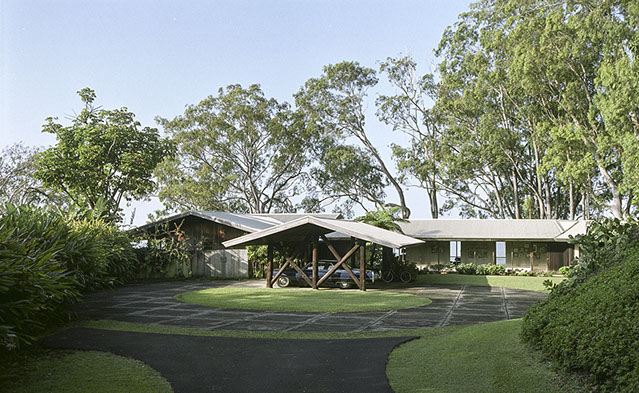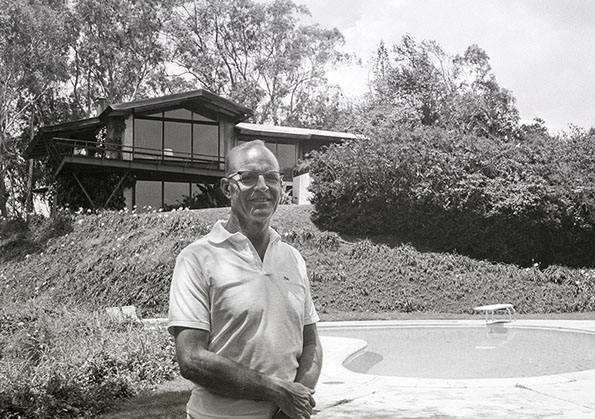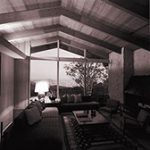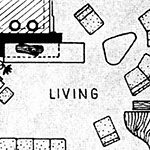Visit the House
About the House
 uilt on the slopes of Pu`u Ohia (Mount Tantalus), overlooking Honolulu, the Liljestrand House is recognized as an outstanding example of Vladimir Ossipoff’s work and of mid-twentieth century modern architecture.
uilt on the slopes of Pu`u Ohia (Mount Tantalus), overlooking Honolulu, the Liljestrand House is recognized as an outstanding example of Vladimir Ossipoff’s work and of mid-twentieth century modern architecture.
The Liljestrands gave Ossipoff a brief list of requirements that shaped the house. The family and Ossipoff worked collaboratively throughout the project. Betty Liljestrand was engaged on a daily basis as general contractor, supervising the crew of craftsmen and carpenters. Even with the language barrier between the Japanese craftsmen and Betty Liljestrand, they found creative ways to communicate when making adjustments throughout the process.
Construction of the House
Please click the image below to view more images in a gallery
The Architect

Vladimir Ossipoff is recognized as the master of Hawai‘i modern architecture. Born in Russia and raised in Japan, Ossipoff was instrumental in the development of Hawaiian architecture that “prioritized cultural contextualization, climatic responsiveness, spatial flexibility, natural harmonies and tactile experience.” Ossipoff created place-sensitive architecture appropriate to the lush topography, light and microclimates of the Hawaiian Islands while synthesizing Eastern and Western influences including Japanese building techniques and modern architectural principles. His seamless integration of building and site, elegant orchestration of circulation, clever management of views, and creative mix of modern and natural materials is apparent in numerous iconic projects throughout Hawai‘i, including the Liljestrand House.

Ossipoff prioritized cultural contextualization, climatic responsiveness, spatial flexibility, natural harmonies and tactile experience.
To commemorate and highlight Ossipoff’s works, a retrospective exhibit, Hawaiian Modern: The Architecture of Vladimir Ossipoff, was organized by Dean Sakamoto and presented at the Honolulu Museum of Art, Yale University School of Architecture Gallery and the German Museum of Architecture in Frankfurt between 2007 and 2009. A 287-page catalog, also entitled Hawaiian Modern: The Architecture of Vladimir Ossipoff, and a film, True to Form, Vladimir Ossipoff Architect, accompanied the exhibit.
The Landscape Architect

The landscape design for the Liljestrand House is credited to Catherine Thompson, also known as Kitty, who was Hawai‘i’s first licensed landscape architect. She collaborated on the design with her husband Robert Thompson. Today, the Liljestrand House landscape differs from the original. Though beautiful, the original design was not sustainable or cost effective for long-term maintenance. The foundation is currently reviewing plans to selectively restore important components of the original design.
The Clients

Betty and Howard Liljestrand arrived in Hawai‘i on December 16, 1937, aboard the S.S. President Coolidge. Betty was originally from Iowa and Howard had been raised in Chengdu, Sichuan, China, by medical missionary parents. The couple had planned to return to China after graduating from college and medical school, but political chaos in China led them to stay in Hawai‘i.
While waiting for the situation in China to change, Howard completed his medical internship and Betty worked as secretary in the x-ray department at the Queen’s Hospital in Honolulu. Though Howard’s parents choose to remain in China, Betty and Howard decided that the situation there was not going to stabilize in the near future. They decided to establish permanent residence in Hawai‘i and began plans to build the Liljestrand House.
The Foundation
Upon Howard Liljestrand’s passing in 2004, his four children inherited Liljestrand House. Recognizing the architectural and historic importance of the property, the family embarked on an 11-year quest to not only save the house but to make it available to the public.
Liljestrand Foundation was created by the Liljestrand family in 2007 with the vision of preserving Liljestrand House, its site and archives, and making that preservation beneficial to the global community. After nearly 8 years of estate settlement challenges, ownership of Liljestrand House was transferred to the Foundation in December 2015. The family retains no ownership of the property, the house or the contents.
Bob Liljestrand was the eldest son of Howard and Betty Liljestrand and served as President and Founding Director of the Foundation until his passing in 2021. Bob’s son Shan Liljestrand currently serves as President of the Foundation. Members of the volunteer Board of Directors provide strategic guidance and support.
Preservation of the house is made possible through donations and public tour and program revenues.
Thank you for opening this beautiful home and keeping the legacy and details alive.
Sign up for E-Newsletter



Image Gallery
View our extensive archive of imagery—including architectural plans, sketches, and photographs.

Plans & Features
Explore the plans to discover clever design features that make The Liljestrand House unique.





